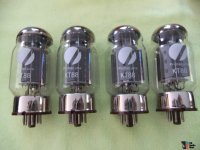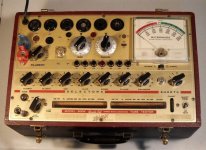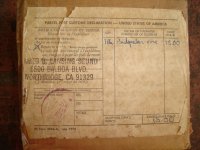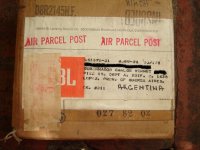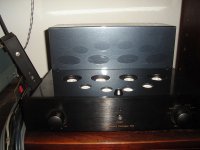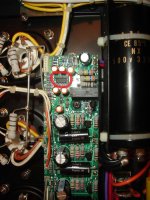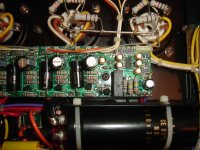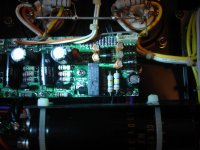One of the four valves of my Prima Luna amplifier is failing, I would like to buy only one because the rest do not have much use. Anyone know where to buy them in the USA ?
They are KT-88, with the PL logo stamped by the factory, but are in actually manufactured by Shuguang from China.
Thanks in advance !
They are KT-88, with the PL logo stamped by the factory, but are in actually manufactured by Shuguang from China.
Thanks in advance !
Attachments
How about Upscale audio
They only have EL-34 with Prima Luna's seal.
Thank you as well
Power Tubes – Upscale Audio
Get a new matched quad, or at least a matched new pair from a reputable
local dealer. Tubes are expendable, trying to reuse old tubes with unknown
properties might cause trouble.
I know, my friend, I know.
I have 4 x EL34 Electro Harmonix and 4 x KT-88 Sovtek
But, I have 3 original tubes (Shuguang-Prima Luna) with 80% remaining life, measured with Hickok tester.
More sound to my taste than Sovtek, I just want to complete the set original KT-88 Prima Luna
Thank you as well.
Attachments
Last edited:
I have written to Prima Luna, they say they test all Shuguang tubes and reject those that do not exceed a minimum quality. Probably that discard is the tubes of the link that you have uploaded E-Bay
Thank you as well
I have written to Prima Luna, they say they test all Shuguang tubes and reject those that do not exceed a minimum quality. Probably that discard is the tubes of the link that you have uploaded E-Bay
I just saw that my query has been removed from Prima Luna's blog ....
I do not understand the reason ...... I hope they reconsider the quality of the after sales service and I respond to the brevity ...
How about Upscale audio
Attachments
If you cannot get the primaluna's you're looking for, I would go for the next best thing.. A quad of shuguang KT88 from a reputable seller, that burns in and tests his own tubes.
Furthermore, the hitchkock testers are in no means parametric testers or tube analyzers, 80% remaining life is a guestimate made by this tester. Based on mostly calculated values. Your shuguang tubes might have measured 100 to 180mA Anode current from the factory. (140 is the middle on the mean distribution if the manufacturer is any good)
The Hichkock is a transconductance tester, that uses poorly regulated voltages. It will achieve a high degree of relative accuracy. Wheras true parametric testers that use regulated voltages and good meters will achieve a high degree of absolute accuracy. Examples of this are the Metrix U61 and Neuberger RMP370/375 (Wheras the latter use rather poorly regulated anode and screen grid voltages, which necessitates adjustment every time a tube draws more or less current. )
The only way for sure to estimate remaining life on an output tube. Is by measuring them directly after burn in at a fixed set of parameters. And then re-measuring them at 500 or 1000 hours intervals.. from this you can extrapolete when the cathode is worn out or when the mu/transconductance drops below a useable level. (Most current production tubes go gassy or short out before the cathode goes...)
Most if not all SQ tubes made by Philips or Telefunken had their end of life specifications well written out in a datasheet, most consumer grade tubes never had any published Min-max readings for the anode current and transconductance these tubes where manufactured to in-house standards. Whereas for example a E88CC was guaranteed to have an anode current and a transconductance in a specified range fresh from the factory box..
One last thing, the Russian SQ series tubes (E, EV suffix) are actually well specified. Atleast their datasheet gives minimum and maximum values for anode current at fixed test voltages.
Furthermore, the hitchkock testers are in no means parametric testers or tube analyzers, 80% remaining life is a guestimate made by this tester. Based on mostly calculated values. Your shuguang tubes might have measured 100 to 180mA Anode current from the factory. (140 is the middle on the mean distribution if the manufacturer is any good)
The Hichkock is a transconductance tester, that uses poorly regulated voltages. It will achieve a high degree of relative accuracy. Wheras true parametric testers that use regulated voltages and good meters will achieve a high degree of absolute accuracy. Examples of this are the Metrix U61 and Neuberger RMP370/375 (Wheras the latter use rather poorly regulated anode and screen grid voltages, which necessitates adjustment every time a tube draws more or less current. )
The only way for sure to estimate remaining life on an output tube. Is by measuring them directly after burn in at a fixed set of parameters. And then re-measuring them at 500 or 1000 hours intervals.. from this you can extrapolete when the cathode is worn out or when the mu/transconductance drops below a useable level. (Most current production tubes go gassy or short out before the cathode goes...)
Most if not all SQ tubes made by Philips or Telefunken had their end of life specifications well written out in a datasheet, most consumer grade tubes never had any published Min-max readings for the anode current and transconductance these tubes where manufactured to in-house standards. Whereas for example a E88CC was guaranteed to have an anode current and a transconductance in a specified range fresh from the factory box..
One last thing, the Russian SQ series tubes (E, EV suffix) are actually well specified. Atleast their datasheet gives minimum and maximum values for anode current at fixed test voltages.
If you cannot get the primaluna's you're looking for, I would go for the next best thing.. A quad of shuguang KT88 from a reputable seller, that burns in and tests his own tubes.
Thanks for the very complete answer
The Hitchkock model that was used to test the valve is not exactly the one I attached, I just took a "borrowed" picture from the internet. I do not know if what you say applies to all models, but it's a secondary thing anyway.
Because a single valve Shuguang failed, with little use, and moderate levels of hearing (I calculate that no more than 300 hours) and I can complete the quad if I get only one valve. I thought it might be easy to buy an "original" Prima Luna KT88 valve in the USA. The Autobias of Prima Luna allows to use valves without pairing, there is no problem to replace only one. It is something very promoted by Prima Luna. You could even use different types of mixed tubes, which obviously would not give a good sound, but technically, no problem. I do not want to buy more complete sets, I already have a Sovtek KT88 quad and a JJ EL34 quad. Dialogue Two is a great amplifier. It really is an advantage not to have to worry about adjusting polarization currents, to be able to switch from pentode to triode during the hearing and to immediately hear the differences of sound, etc.
A few days ago I received an email from Prima Luna, I had a little hope when I saw the same, and a great disappointment when I opened it. It was the copy of my query in Prima Luna's blog, sent automatically by a robot ... Something like a receipt.
Communicating by letter, many years ago (1982), JBL solved a problem with a tweeter, sending the replacement directly to my address !
Notice the difference ?
Sorry OT !
Attachments
Last edited:
My personal opinion is that primaluna gear is what to be expected of a Chinese product.. Ok the build quality is good for the money.. However they sell CD players that come stock with two GZ34 rectifiers.. Whilst the current consumption of the L+R driver stages shouldn't be more than 40-50mA. A single 6X4 would have sufficed in that position. Furthermore, they cheaped out on using some soft recovery diodes in series with the rectifier anodes. So if your GZ34 develops a short (Which the Chinese valves occasionally do) good luck getting a replacement mains transformer, if they supply them at all.
Their "Autobias" circuit, is a simple RC controlled bias servo that works with a 10 cent opamp and some applied hysteresis use one of the search engines and you'll see that its not that special.. about 20 dollars for ten PCB's and 30-40 dollars for parts, you can assemble 10 of them..
However use MKP's or SMD multilayer ceramics for the RC low pass filters, because their use of electrolytic capacitors can cause trouble when they start leaking...
/Rant mode off.
You could try buying a used pair or quad of the valves and select the one that measures closest to your three remaining ones. Matching tubes on lifetime is only useful when there is a degree of inherent quality in the valves... No amount of burning in and "Selecting" is going to make up for the inherent quality issues of modern tubes. Cathode emission is pretty unstable... and hence mu varies over time as well.
I don't really trust most outlets that claim to select and burn in their tubes... If they don't supply verifiable measurements on their products.. Most supplied boxes only state some anode current and a measured mutual conductance at some arbitrary point... Whilst the test specifications for example the GEC KT88 where pretty clear.. Compare this with any modern semiconductor and you'l notice the difference... Tolerances and test methods are almost always included in the datasheet...
Their "Autobias" circuit, is a simple RC controlled bias servo that works with a 10 cent opamp and some applied hysteresis use one of the search engines and you'll see that its not that special.. about 20 dollars for ten PCB's and 30-40 dollars for parts, you can assemble 10 of them..
However use MKP's or SMD multilayer ceramics for the RC low pass filters, because their use of electrolytic capacitors can cause trouble when they start leaking...
/Rant mode off.
You could try buying a used pair or quad of the valves and select the one that measures closest to your three remaining ones. Matching tubes on lifetime is only useful when there is a degree of inherent quality in the valves... No amount of burning in and "Selecting" is going to make up for the inherent quality issues of modern tubes. Cathode emission is pretty unstable... and hence mu varies over time as well.
I don't really trust most outlets that claim to select and burn in their tubes... If they don't supply verifiable measurements on their products.. Most supplied boxes only state some anode current and a measured mutual conductance at some arbitrary point... Whilst the test specifications for example the GEC KT88 where pretty clear.. Compare this with any modern semiconductor and you'l notice the difference... Tolerances and test methods are almost always included in the datasheet...
Their "Autobias" circuit, is a simple RC controlled bias servo that works with a 10 cent opamp and some applied hysteresis use one of the search engines and you'll see that its not that special.. about 20 dollars for ten PCB's and 30-40 dollars for parts, you can assemble 10 of them..
Well, this sentence if that is a surprise for me...
Autobias is only a few cents and is simply a very common operational amplifier?
Or you buy very cheap or I was cheated, I paid $ 3200 for Dialogue Two .......
Adaptive AutoBias — PrimaLuna USA
On one occasion I replaced the common fuses with the audiophile  Little Fuses and took some pictures of the Dialogue Two Autobias.
Little Fuses and took some pictures of the Dialogue Two Autobias.
Here is the operational amplifier, I can not see its denomination...
Anyone know? Just to know, I forgot to take note at that time...
Thanks in advance
Here is the operational amplifier, I can not see its denomination...
Anyone know? Just to know, I forgot to take note at that time...
Thanks in advance
Attachments
Well in higher end products you pay for the Brand not the product..
The primaluna's are much better then most of the Chinese amplifiers, their layout is good. However Shelling out a few hundred more for a bias servo PCB that costs them maybe 25Us to install is madness in my opinion.
I am not going to link to their circuit to avoid any trouble altogether. However suffice to say it is a very basic analog circuit.. That comes with its own set of drawbacks..
If you're using audiophile fuses.. Well I have just the thing for you: Magic beans..
The primaluna's are much better then most of the Chinese amplifiers, their layout is good. However Shelling out a few hundred more for a bias servo PCB that costs them maybe 25Us to install is madness in my opinion.
I am not going to link to their circuit to avoid any trouble altogether. However suffice to say it is a very basic analog circuit.. That comes with its own set of drawbacks..
If you're using audiophile fuses.. Well I have just the thing for you: Magic beans..
If you're using audiophile fuses.. Well I have just the thing for you: Magic beans..
If there are magic wires, feet for cabinets that do miracles, welds of silver alloys, etc ... fuses, why not?
I have very good ear, maybe you do not .......
I am merely giving my opinions, as a electrotechnically schooled youth.
There is much in the audio world that is merely snake oil, little technical and verifiable data.
For example: a good indication of electron tube inherent quality is grid current measurements over the lifetime of a certain tube. In my opinion it is more important then even the fundamental parameters such as Ri and S. Because from this you can deduce the quality and consistency of the cathode coating and vacuum, two of the parameters where the current manufacturers drop the ball. A tube will function regardless if the grid is slightly out of manufacturing tolerance. But if the tube degasses during use, or the cathode sputters some material on G1, this can have sparks and fried output transformers as a result.
There is much in the audio world that is merely snake oil, little technical and verifiable data.
For example: a good indication of electron tube inherent quality is grid current measurements over the lifetime of a certain tube. In my opinion it is more important then even the fundamental parameters such as Ri and S. Because from this you can deduce the quality and consistency of the cathode coating and vacuum, two of the parameters where the current manufacturers drop the ball. A tube will function regardless if the grid is slightly out of manufacturing tolerance. But if the tube degasses during use, or the cathode sputters some material on G1, this can have sparks and fried output transformers as a result.
- Status
- This old topic is closed. If you want to reopen this topic, contact a moderator using the "Report Post" button.
- Home
- Amplifiers
- Tubes / Valves
- Where do I buy kT88 of Prima Luna in USA ?
